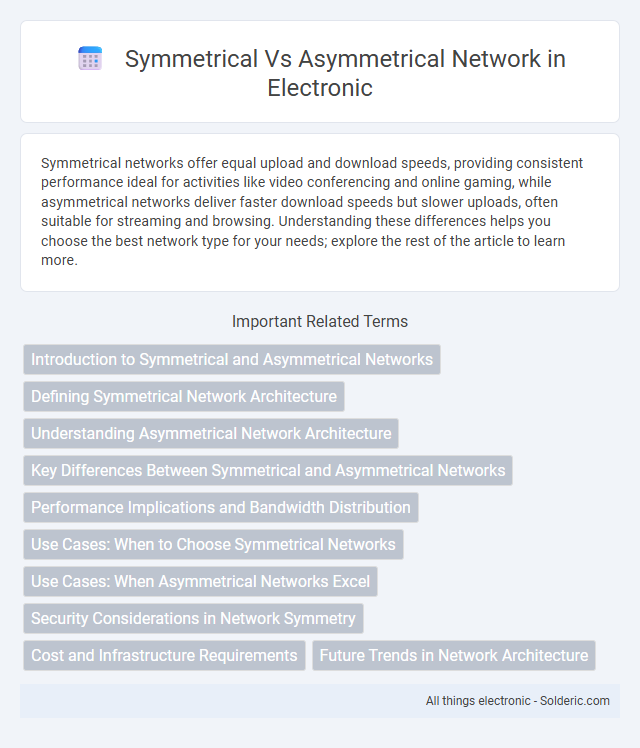Symmetrical networks offer equal upload and download speeds, providing consistent performance ideal for activities like video conferencing and online gaming, while asymmetrical networks deliver faster download speeds but slower uploads, often suitable for streaming and browsing. Understanding these differences helps you choose the best network type for your needs; explore the rest of the article to learn more.
Comparison Table
| Aspect | Symmetrical Network | Asymmetrical Network |
|---|---|---|
| Data Transfer Speed | Equal upload and download speeds | Faster download than upload speeds |
| Use Case | Video conferencing, cloud services, online gaming | Web browsing, streaming, downloads |
| Cost | Generally higher due to balanced bandwidth | More affordable, optimized for download-heavy activities |
| Examples | Fiber optic connections, business-grade internet | DSL, cable internet for residential users |
| Reliability | Better for bidirectional communication | May experience slower uploads affecting some tasks |
Introduction to Symmetrical and Asymmetrical Networks
Symmetrical networks provide equal upload and download speeds, making them ideal for activities such as video conferencing, online gaming, and cloud computing where consistent data flow is crucial. Asymmetrical networks offer higher download speeds compared to upload speeds, commonly used in residential internet services where downloading content is prioritized over uploading. Understanding the differences between these network types helps you choose the right internet connection based on your specific data transfer needs and usage patterns.
Defining Symmetrical Network Architecture
Symmetrical network architecture features equal bandwidth and performance capacity in both upload and download directions, ensuring balanced data flow. This design enhances reliability and efficiency for activities like video conferencing or cloud computing where consistent two-way communication is critical. Your network experiences reduced latency and improved synchronization, making symmetrical architecture ideal for demanding, real-time applications.
Understanding Asymmetrical Network Architecture
Asymmetrical network architecture allocates different bandwidth capacities for uploading and downloading, optimizing resource allocation based on user demand patterns. It is commonly utilized in consumer broadband services where download traffic significantly exceeds upload traffic, enhancing overall network efficiency. This design contrasts with symmetrical networks, which provide equal bandwidth in both directions, typically essential for enterprise applications requiring balanced data flow.
Key Differences Between Symmetrical and Asymmetrical Networks
Symmetrical networks provide equal bandwidth for both upload and download speeds, enhancing performance for activities like video conferencing and cloud computing. Asymmetrical networks offer higher download speeds compared to upload speeds, which suits typical web browsing and streaming behaviors. Your choice depends on whether balanced data flow or download priority better supports your online needs.
Performance Implications and Bandwidth Distribution
Symmetrical networks provide equal upload and download speeds, resulting in consistent performance for applications requiring balanced bandwidth, such as video conferencing and cloud storage. Asymmetrical networks prioritize download speed over upload speed, which can lead to bottlenecks in tasks with heavy upstream data, negatively impacting real-time communication and remote work efficiency. Understanding bandwidth distribution is crucial for optimizing network infrastructure to meet specific workload demands and enhance overall user experience.
Use Cases: When to Choose Symmetrical Networks
Symmetrical networks are ideal for use cases requiring equal upload and download speeds, such as video conferencing, online gaming, cloud computing, and remote work environments. They support seamless data transmission in both directions, enhancing real-time collaboration and reducing latency. Businesses relying on large file transfers or interactive applications benefit significantly from symmetrical network connections.
Use Cases: When Asymmetrical Networks Excel
Asymmetrical networks excel in use cases where download speed significantly outweighs upload requirements, such as streaming video, online gaming, and web browsing, providing efficient bandwidth for content consumption. These networks are ideal for residential users and small businesses focused on receiving large amounts of data rather than sending it. Your experience improves during activities like video conferencing and cloud-based entertainment, where faster downstream capacity enhances overall performance.
Security Considerations in Network Symmetry
Symmetrical networks offer enhanced security through uniform data flow and simplified monitoring, reducing vulnerabilities caused by unpredictable traffic patterns. In contrast, asymmetrical networks can create blind spots and increase the risk of unauthorized access due to uneven distribution of data paths. Security protocols and intrusion detection systems perform more effectively in symmetrical network environments, facilitating consistent threat detection and mitigation.
Cost and Infrastructure Requirements
Symmetrical networks often demand higher infrastructure investment due to equal upload and download speeds requiring advanced equipment and bandwidth capacity, resulting in increased costs. Asymmetrical networks reduce costs by allocating more bandwidth to download speeds, utilizing less expensive infrastructure suited for common user activities like streaming and browsing. Your choice depends on budget constraints and specific needs for balanced data transmission versus prioritizing download efficiency.
Future Trends in Network Architecture
Future trends in network architecture emphasize a shift towards more asymmetrical network designs to accommodate the increasing demand for asymmetric data flows, particularly from cloud services and IoT devices. Symmetrical networks, while still valuable for certain enterprise applications, are being augmented with adaptive routing and dynamic bandwidth allocation techniques to optimize performance and resource utilization. Advances in 5G and edge computing further drive the evolution of network architectures that balance symmetry and asymmetry based on application-specific requirements and traffic patterns.
symmetrical vs asymmetrical network Infographic

 solderic.com
solderic.com